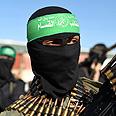
Hamas issues own textbooks for Gaza children, shaping ethos
New curriculum omits Oslo Accords, claims Jews, Zionists unrelated to 'extinct nation of Israel,' boasts Hamas 'drove Zionists into shelters' during Pillar of Defense Operation
Among other points, the books, used by 55,000 children in the eighth, ninth and 10th grades as part of a required “national education” course of study in government schools, do not recognize modern Israel, or even mention the Oslo Peace Accords the country signed with the Palestine Liberation Organization in the 1990s.
Related stories:
- Study: No demonization in PA's school books
- Arab teachers: Kids compare Shoah to conflict
- Hamas appoints female writer as spokesperson
Beyond their take on Israel, the new texts are also a salvo in the war for influence between the rival Palestinian factions: Gaza-based Hamas and Fatah , which dominates the Palestinian Authority and the West Bank. They reflect a growing gulf between the 1.7 million Palestinians living in the densely populated Gaza Strip and the 2.5 million spread among the West Bank’s cities and villages.
“Textbooks are always and everywhere a very important means of representing a national ethos,” Daniel Bar-Tal, a Tel Aviv University professor who helped lead a comprehensive recent study of Israeli and Palestinian textbooks, told the Times.
“When a leader says something, not everyone is listening. But when we talk about textbooks, all the children, all of a particular peer group, will be exposed to a particular material,” he added. “This is the strongest card.”
What Gaza teenagers are reading in their 50-page hardcover texts this fall includes references to the Jewish Torah and Talmud as “fabricated,” and a description of Zionism as a racist movement whose goals include driving Arabs out of all of the area between the Nile in Africa and the Euphrates in Iraq, Syria and Turkey.
“Palestine,” in turn, is defined as a state for Muslims stretching from the Jordan River to the Mediterranean Sea. A list of Palestinian cities includes Haifa, Beersheba and Acre — all within Israel’s 1948 borders.
According to the report, the books rebut Jewish historical claims to the territory by saying, “The Jews and the Zionist movement are not related to Israel, because the sons of Israel are a nation which had been annihilated.”
'Books show cruelty of occupation'
For contemporary history, there is a recounting of Hamas’s battle with Israel last fall that exaggerates: The books say that rockets from Gaza sent “three million Zionists underground for eight days” (somewhat fewer Israelis were in and out of shelters sporadically), that Tel Aviv was hit (one missile landed in the sea, and another fell well short) and that an attempted strike on Israel’s Parliament building “forced the Zionists to beg for cease-fire.”
Hamas officials said they had introduced the new textbooks, and doubled the time devoted to the national education course to two sessions per week, because they believed that the Palestinian Authority was under pressure from Israel to sanitize its curriculum. “We need to make sure generations stick to the national rights,” said one Hamas lawmaker, Huda Naim.
The Gaza Strip is home to 465,000 students. The United Nations Relief and Works Agency, which supports Palestinian refugee families, runs 250 schools for grades one to nine, and the Hamas government controls 400 schools serving all grades (there are also 46 private schools).
The new books, written by a Hamas committee, feature cover pictures of Al Aqsa Mosque in Jerusalem and the Cave of the Patriarchs in Hebron, a West Bank city, both sites of continuing clashes between Muslim and Jewish worshipers.
Anound Ali, a 10th grader at another Gaza City school, expressed concern that the new books could further divide Palestinians. “School textbooks were the last thing uniting us with the West Bank — now we study something different,” she said one recent day after class.
She added: “The book has nothing about Oslo. It’s our right to know about Oslo because it’s a fact in our life.”
At Suliman Sultan School here in Gaza City, a three-story L-shaped building overlooking the rubble of a stadium destroyed by an Israeli F-16 airstrike last November, many students and teachers were thrilled to have the new textbooks.
“It shows the cruelty of the occupation,” Ahmed Bessisso, a 15-year-old student in the class that discussed the 1929 uprising, told the Times. “It encourages students to participate in national activities.”
Ahmed’s classmate Mohamed Ajour, also 15, said that he preferred “to study the history of Palestine instead of the history of Egypt or Jordan,” and that the books present the “Palestine I want to learn about — I don’t recognize that Palestine is only Gaza and West Bank.”
Munir Qatayef, who teaches another national education section in the school, said the book had been “big for students.”
“It’s highly politicized,” Mr. Qatayef said. “It’s a lesson of nationalism and belonging.”
- Receive Ynetnews updates directly to your desktop










